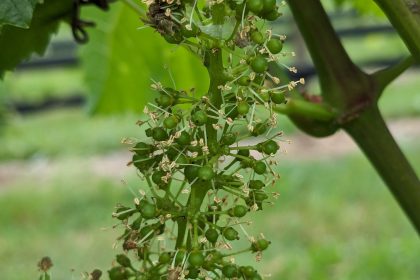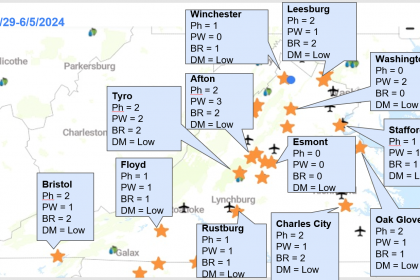As if almost a week of thunderstorms and rains was not enough, it looks like we are expecting even more rain in the coming week.
Hopefully, you had a good protection before the rain, but even if you did, rain more than 1-2 inches can wash the material away from the canopy. Please see the article from Dr. Annemiek Schilder about rain and wash off of fungicide. Her work suggests that although only a 0.04 inch of rain can wash a certain percentage of a material from the leaf, it takes about 1-2 inches to actually having a negative effect on the efficacy since the rate you apply is typically much higher than the threshold for the efficacy of the material.
When we have the next chance of application, what material(s) should we apply? I think many of us are about 2-4 weeks away from the bloom, so, the major concern is downy mildew. If you think you have missed the window (i.e., there were more than 2 inches of rain from the last application of a fungicide against downy mildew, or it has been more than 10 days from the previous application), it is probably a good idea to have a phosphite material (FRAC = 33) such as Prophyt, Phostrol, etc. It has a kickback activity against downy mildew (i.e., it can stop the ongoing infection process). While you are at it, it probably a good idea to mix with a protective material (e.g., captan (FRAC = M4), or mancozeb, ziram (FRAC = M3), or Revus, Forum (FRAC=40), or Zampro (FRAC=40+45), or Ranman (FRAC = 21)). If your vines are within two weeks of bloom, it is probably better to include mancozeb plus a QoI (FRAC=11, e.g. Abound, Flint, etc) or a DMI (FRAC=3, e.g., Rally, Mettle, etc) for black rot.
The other potential scenario is that you have applied materials just before the recent rain events, so, you might not be too concerned about the missing window, but you want to have an insurance against the upcoming week of rain. If that fits, a copper (FRAC=M1) material might be a good fit. It is more economical than other materials, has a good efficacy against downy mildew, and it tends to do better under frequent rain condition. There are several newer copper materials that cause fewer phytotoxicity issues even on relatively copper sensitive cultivars (e.g., Cueva, Champ, etc). The copper material is not effective against black rot, so, if your vines are near bloom, make sure to have mancozeb plus a QoI or a DMI for black rot.
(Addendum 17 May 2018) I received an email about the use of Ridomil products (FRAC = 4 + M3 (MZ) or + M1(Copper)), which have excellent kick-back activity against downy mildew. Typically, I recommend the use of phosphite as noted above because Ridomil products have known fungicide resistance issue. However, with the current rain situation (plus more on the forecast), Ridomil products could be a good option too. Please make sure not to spray too many times. Although you could apply up to four times according to the label, my recommendation is to limit the use of it to twice a season. We have too many fungicide resistance issues in our state, and and the overuse (and misuse) of a product is the most likely cause. Also, although Ridomil MZ has mancozeb, the concentration of mancozeb will be less than our typical recommendation (3 lb/A). You may want to adjust it by adding mancozeb (to meet 3 lb/A) or other a material(s) to cover black rot.
Another question came to my attention was about the difference between the QoI and DMI in regards to their kickback activity against black rot. In between them, the DMI is known to have a better (i.e., reach out longer) kickback activity than the QoI. So if you are in doubt about black rot, a DMI maybe a better option (but also think about powdery mildew. With this rain, I am not too concerned about powdery now, but you may need to keep the DMI for powdery too.)






Question: Several years ago, I applied phosphite at a rate of 4-8oz/gallon based on the direction of "2.5-5 pints per 10 gallons per acre". My vines reacted very badly. I was later told I probably should have used 0.5-1 oz per gallon. I have not used phosphite since, but with the recent persistent rains I am considering an application again. Can you please advise on the correct dilution? Also, can Captan and Sulfur be applied at the same time? If not, within how many weeks?
It depends on the formulation of the phosphite you obtained because they differ in the percent of a.i. in the product. Please make sure to read the label. It is typically in the range of 3-4 pints per acre and assuming 100 gallons (not 10) of water to be used per acre. Some products gives you a percentage (or ratio of the product and water) that you should aim for too. Once again, the ratio will differ depending on the product, so, make sure to read the label.
You can mix captan and sulfur with a phosphite.